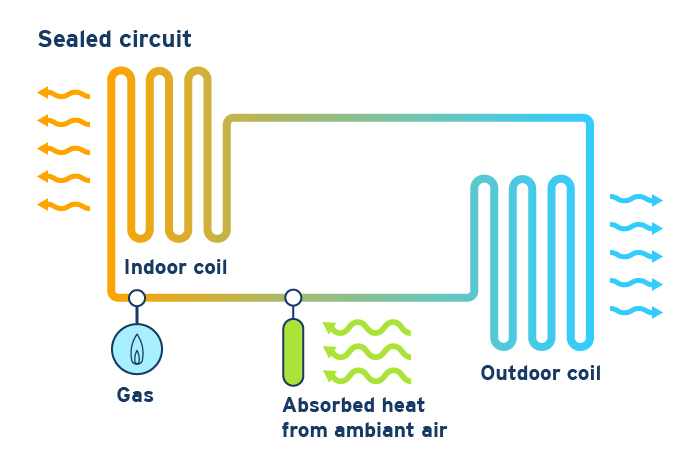Gas absorption heat pump rebates for non-profit organizations

Up to
$200,000
-
Customer
Gas customer
-
Non-profit type
Housing services
Other services
-
Project type
Existing building
Save energy, save money and reduce greenhouse gas emissions with high-efficiency gas absorption heat pumps to provide space heating, domestic hot water and/or ventilation for non-profit housing or charities serving income-qualified people. Our energy solutions managers are here to answer your questions and help you get rebates to reduce the upfront cost of this innovative heating technology.
To help you determine if a gas absorption heat pump system is a fit for your building or facility, and to reduce the cost of installation, the program offers both feasibility study funding and product rebates.
Like conventional heat pumps, gas absorption heat pumps capture heat from the outdoor air and transfer it indoors for space heating, domestic hot water and/or ventilation. Using gas to transfer heat, rather than directly heating air or water, they can achieve energy efficiencies of more than 100 per cent.1 They can also operate on renewable and lower carbon gases,2 such as Renewable Natural Gas.3

To help you understand this technology better and share insights on how it’s being implemented in B.C, we created a best practices guide together with CLEAResult. Access the guide.
Item | Amount | Details |
|---|---|---|
Feasibility study funding | Up to $20,000 | work with your engineering consultant to submit a feasibility study proposal to FortisBC to apply for this funding |
Gas absorption heat pumps | 75 per cent of the total project costs, up to $200,000 | for installing gas absorption heat pumps in a building that provides services and/or housing for income-qualified people |
- You must be a FortisBC commercial natural gas customer who owns or operates a registered charity that provides assistance to income-qualified persons, or a housing provider that is:
- a local government
- a housing society registered under the Societies Act
- a housing co-op registered under the Cooperative Association Act or
- a governing body of an Indigenous band, provided the housing is primarily for low-income households
- Note: non-profit top-up participants do not include:
- school boards or educational institutions
- health authorities or hospitals
- public libraries
- You must be a property owner or long-term leaseholder of an existing commercial building.
- The building must have dedicated outdoor space (ground level or rooftop) to house the gas absorption heat pump unit(s).
- The gas absorption heat pump must replace an existing gas heating system that serves as the building's primary source of heating.
- You must submit an application and supporting documentation no later than 365 days after the purchase date of the product(s) (as shown on the paid invoice) or installation date (as listed on the application form), whichever is first.
- Note: Gas equipment, including boilers, water heaters and furnaces, that are less than 100 per cent efficient, are not eligible for a rebate and must not be included in the total project cost.
Gas absorption heat pump product eligibility
Gas absorption heat pumps from manufacturers including (but not limited to) the following are eligible for rebates:
- Robur- available through JSA Sales
- Vicot- available through Homy Building Solutions
- ANESI - available through Canadian Aqualine
If you have questions about rebate-eligible heat pumps, contact us.
- Work with the engineering consultant of your choice to develop a feasibility study proposal for a gas absorption heat pump for your building or facility, including the information outlined above, and submit the proposal to FortisBC. We’ll review it, and if approved, you may proceed with the full feasibility study.
- The feasibility study proposal should clearly define the scope and cost of the feasibility study, including:
- a brief description of the facility, including location, site contact and overview of operations
- a brief description of the gas absorption heat pump(s) and any additional condensing boiler(s) and/or condensing water heater(s) and controls to be studied
- the proportion of the facility’s natural gas and/or electricity consumption that the system being studied consumes
- pre-study estimates of heat pump cost and energy savings
- methods used to estimate or model energy savings
- an overview of any previous studies or work that has identified the heat pump as an opportunity to improve the energy efficiency of the facility
- the name of the lead individual who will be responsible for conducting the feasibility study and completing the report
- the total estimated feasibility study cost, including itemized costing broken down by job role, named individual, hourly rate, anticipated number of hours and budgeted expenses (such as travel)
- a list of data and metering points required to complete the feasibility study and expected limitations on the scope of study
- Submit the completed feasibility study and the paid invoice from your consultant to FortisBC to receive feasibility study funding.
Gas absorption heat pump rebates
- Before you buy a gas absorption heat pump, ensure it's eligible for the rebate. If you have questions, contact us before purchasing and installing equipment.
- Have a gas or mechanical contractor licensed with Technical Safety BC install your heat pump system. You can find one through our Trade Ally Network.
- Apply online for your gas absorption heat pump rebate 365 days of the purchase date (as shown on the paid invoice) or installation date (as listed on the application form), whichever is first. Be sure to provide copies of the fully paid invoice including make and model number of the eligible heat pump(s) purchased and installed.
Additional details
The application link takes you to Account login. Once you've registered and/or logged in you can start your application. Hint: we recommend using Google Chrome® for the best experience.
Our Energy Conservation Assistance Program can help income-qualified residents save energy with a free home energy evaluation, installation of energy-saving products and advice. Plus, we can work with you to coordinate the delivery of the program to multiple units in a complex.
What are gas heat pumps and do they save money and energy?
Gas absorption heat pumps can help commercial organizations lower operational costs while reducing energy use and greenhouse gas emissions.
What are gas heat pumps and how can they help save money and energy?
1As reported in 2021 measurement and verification results for FortisBC’s gas absorption heat pump pilot program, in which Robur-A gas absorption heat pumps were installed for domestic hot water heating at seven sites in BC.
2FortisBC uses the term renewable and lower carbon gas to refer collectively to the lower carbon gases or fuels that the utility can acquire under the Greenhouse Gas Reduction (Clean Energy) Regulation, which are: Renewable Natural Gas (also called RNG or biomethane), hydrogen, synthesis gas (from wood waste) and lignin. FortisBC's renewable and lower carbon gas portfolio currently includes only Renewable Natural Gas. Other gases and fuels may be added to the program over time. Depending on their source, all of these gases have differing levels of lifecycle carbon intensity. However, all of these gases are lower carbon when compared to the lifecycle carbon intensity of conventional natural gas. The current burner tip emission factor of RNG is 0.27 grams of carbon dioxide equivalent per megajoule of energy (gCO2e/MJ) and the current renewable and lower carbon gas portfolio lifecycle emissions for stationary combustion are -22 gCO2e/MJ. This is below B.C.'s lifecycle carbon intensity threshold of 30.8 gCO2e/MJ as set out in the 2024 Greenhouse Gas Reduction Regulation amendments.
3Renewable Natural Gas (also called RNG or biomethane) is produced in a different manner than conventional natural gas. It is derived from biogas, which is produced from decomposing organic waste from landfills, agricultural waste and wastewater from treatment facilities. The biogas is captured and cleaned to create RNG. When RNG is added to North America’s natural gas system, it mixes with conventional natural gas. This means we’re unable to direct RNG to a specific customer. But the more RNG is added to the gas system, the less conventional natural gas is needed, thereby reducing the use of fossil fuels and overall greenhouse gas emissions.

Up to
$200,000
For tips on using the online application, read our how-to-guide.
We're here to help
If you have questions, contact our key account manager for affordable housing or email email [email protected].